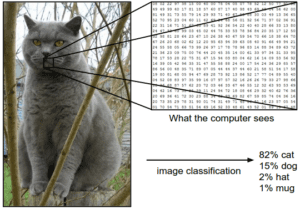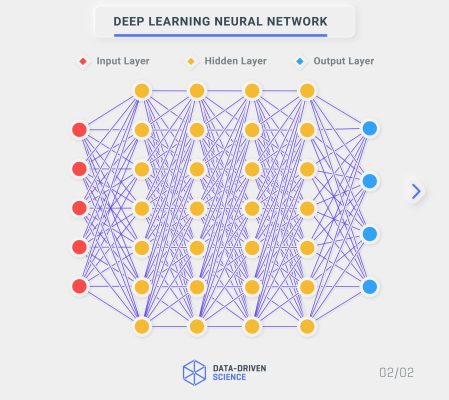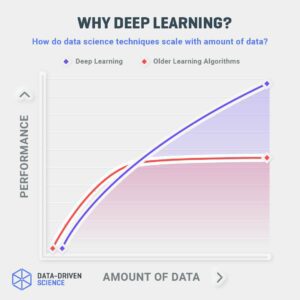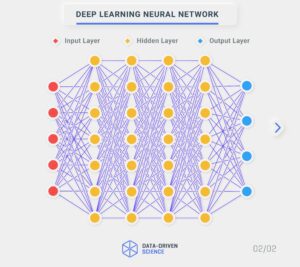It’s not who has the best algorithm that wins; It’s who has the most data
— Andrew Ng
What is Deep Learning
Deep learning is a subset of machine learning that is based on the idea of artificial neural networks. These networks are modeled after the human brain and are designed to process large amounts of data in order to make predictions or decisions. In the case of image classification, a deep learning algorithm is trained on a large dataset of labeled images in order to learn how to identify objects within images.
Why Deep Learning
Deep learning is a subset of machine learning that uses neural networks with multiple layers to analyze and model data. These multiple layers allow for the extraction of more complex and abstract features, which can improve the accuracy of predictions. Additionally, deep learning models can handle large amounts of data and can automatically learn features without the need for manual feature engineering. This makes them well suited for tasks such as image and speech recognition, natural language processing, and self-driving cars. While machine learning also uses algorithms to analyze data, it typically does not use as many layers or as much computational power as deep learning.
What is a Neural Network
A neural network is a type of machine learning model that is inspired by the structure and function of the human brain. It is composed of layers of interconnected “neurons,” which are simple mathematical functions that process input data and pass it on to other neurons in the next layer.
Each neuron receives input from other neurons, performs a computation on them, and then passes the result on to the next layer. The inputs are usually the features of the data being analyzed and the computation is performed by a set of parameters called weights and biases.
The output of the final layer of neurons is the model’s prediction. The process of training a neural network involves adjusting the weights and biases to minimize the difference between the predicted output and the actual output.
Neural networks can be used for a wide range of tasks such as image recognition, natural language processing, speech recognition, and decision making. The architecture of a neural network can vary depending on the task, it can be feedforward, recurrent, convolutional, and many more.
Introduction to Image Classification
Image classification is the process of identifying objects within digital images. This can be done manually by a human, but it is often more efficient to use a computer algorithm to perform the task. One of the most effective ways to classify images is by using deep learning, a type of machine learning that uses neural networks to classify images.

Role of Convolutional Neural Networks (CNNs)
A CNN is a type of neural network that is specifically designed to process data that has a grid-like structure, such as an image, and are therefore particularly well-suited for image classification tasks.. It consists of an input layer, multiple hidden layers, and an output layer. The hidden layers typically include a series of convolutional layers, which apply a set of filters to the input image to extract features, and pooling layers, which reduce the spatial dimensions of the feature maps.
The output layer of a CNN for image classification is typically a fully connected layer, which receives the features extracted by the convolutional and pooling layers and produces a probability distribution over the possible classes. The class with the highest probability is the model’s prediction for the input image.
To train a CNN for image classification, a large dataset of labeled images is required. The model learns to classify images by adjusting the weights and biases of the layers during the training process to minimize the difference between the predicted output and the actual output.
The trained model can then be used to classify new images, by providing the image as input to the trained model it will produce a probability for each class, and the class with the highest probability will be the output of the model.
Training a CNN for Image Classification
A CNN is trained using a large dataset of labeled images. This training process is done in order to teach the CNN how to recognize different objects within images. The CNN learns to identify objects within images by adjusting the weights of its neurons based on the labeled examples it is shown.
The process of training a CNN involves showing it a large number of labeled images and adjusting the weights of its neurons based on the labeled examples it is shown. The CNN learns to identify objects within images by adjusting the weights of its neurons based on the labeled examples it is shown. The more images the CNN is trained on, the more accurate it becomes at identifying objects within images.
Using a Trained CNN for Image Classification
Once a CNN has been trained, it can be used to classify new images. This is done by feeding an image through the CNN and using the output to make a prediction about the objects within the image. The output of the CNN is a list of probabilities, which indicate the likelihood that the image contains each object that the CNN has been trained to recognize.
The process of using a trained CNN for image classification is relatively simple. An image is fed into the CNN, and the CNN produces a list of probabilities indicating the likelihood that the image contains each object that it has been trained to recognize. The object with the highest probability is considered to be the most likely object within the image.
Practical Applications of Image Classification using Deep Learning
Image classification using deep learning has many practical applications in the real world. Some examples include:
- Self-driving cars: Self-driving cars use image classification to identify objects such as cars, pedestrians, and traffic signals within images. This allows the car to make decisions about how to navigate the road safely.
- Facial recognition: Facial recognition systems use image classification to identify specific individuals within images. This technology is used in security systems, as well as in applications such as unlocking a smartphone or logging into a computer.
- Medical imaging: Medical imaging systems use image classification to identify specific structures within images, such as tumors or blood vessels. This can be used to diagnose and treat diseases such as cancer.
These are just a few examples of the many ways in which image classification using deep learning is being used in the real world. With the increasing availability of large datasets and powerful computing resources, image classification using deep learning is likely to become an even more important technology in the future.
Summary
Image classification is the process of identifying objects within digital images. Deep learning is a powerful technique for performing image classification using neural networks. CNNs are a type of neural network that are particularly well-suited for image classification tasks. They use convolution processes to identify patterns within images. A CNN is trained using a large dataset of labeled images and it can be used to classify new images by feeding through the CNN and using the output to make a prediction about the objects within the image. Real-world examples of image classification using deep learning include self-driving cars, facial recognition and medical imaging.




